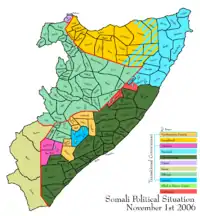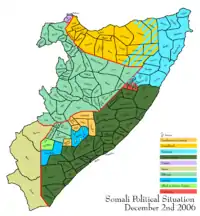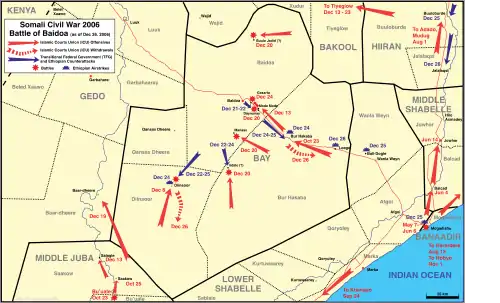Battle of Baidoa
The Battle of Baidoa began on December 20, 2006 when the Somali Somali Transitional Federal Government's forces (TFG) allied with occupying Ethiopian forces attacked the Islamic Courts Union (ICU).
| Battle of Baidoa | |||||||
|---|---|---|---|---|---|---|---|
| Part of the Somalia War (2006–2009) | |||||||
| |||||||
| Belligerents | |||||||
|
Islamic Courts Union |
| ||||||
| Strength | |||||||
| 5,000+ militia |
3,000+ TFG militia, 5,000+ Ethiopian soldiers | ||||||
| Casualties and losses | |||||||
|
1,000 Somali Islamists dead[3] 800+ wounded[4] | 400 killed (Islamists claim)[5] | ||||||
Prelude

November 26, 2006
The day after Ethiopian forces fired missiles at Bandiradley an Ethiopian truck exploded in a convoy 5km from the military training ground of Minaas, 35km from Baidoa. The explosion was said to have been caused by a remote controlled bomb. Senior Islamic Courts Union member Mohamed Ibrahim Bilaal said about 20 Ethiopians died in the explosion. Following the explosion there was said to have been a brief exchange of fire with Islamist militiamen. The United Nations condemned the incident, saying that the increase of weapons in Somalia was a contravention of the 1992 Arms Embargo on Somalia. The TFG claimed that the incident never took place. [6]
November 30, 2006
A suspected car bomb exploded in Bakin, on the approaches to Baidoa, on November 30. The minibus had served carrying people between Mogadishu and Baidoa.[7]

ICU surrenders
On December 3, it was reported in an Amharic newspaper The Ethiopian Herald that 60 ICU militiamen had surrendered to TFG forces in Baidoa, along with their technicals, the newspaper reported that were dissatisfied by extremist policies arising within the Islamic Courts Union.[8]
UN Peacekeeping Force
On December 6, the United Nations Security Council approved a deployment of IGAD peacekeepers exempt from the UN arms embargo to protect Baidoa. Ethiopia, Kenya and Djibouti were barred from taking part in the peacekeeping operation, leaving it up to Uganda, Tanzania and Eritrea, primarily Uganda. [9] In a press statement the Eritrean Permanent Mission to the United Nations officially denied its nation had any troops in Somalia.[10]
December 8, 2006
On December 8, TFG backed by Ethiopian troops (according to eyewitnesses) attacked the Islamic Courts Union militias in the town of Dinsoor, 110km southwest of Baidoa, sparking heavy fighting. The International Committee of the Red Cross reported that the attack had happened amidst serious flooding while thousands of civilians were trying to escape floodwaters. Kofi Annan stressed the importance of communicating with the ICU and their supporters that UN peacekeepers were coming to help. The UN had accused Ethiopia of breaking the arms embargo and it was their intention to send more neutral foreign forces to support the TFG. All telecommunications to Dinsoor were immediately cut off and the TFG once again denied the involvement of Ethiopian troops.[11]
December 13, 2006
The settlement of Ufurow, 90 km from the interim government capital at Baidoa, capitulated to the ICU without any fighting. ICU militias were said to be within 20 km of Baidoa near Buurhakaba.[12] Shabelle Media Network reported that ICU chairman was planning to fly to Yemen for talks.[13]
December 19, 2006
Abdulrahim Ali Modei, the information minister for the ICU gave assurances that the Islamic Courts Union did not intend to attack the Ethiopian army. He said that the deadline the ICU had given the Ethiopians to remove their armed forces from Somali soil had been for guidance and that the ICU were still "hoping for peace". The TFG in an apparently sudden change of direction said that they were also holding fire".[14]
Battle of Baidoa
The Battle of Baidoa began on December 20, 2006 when the TFG allied with occupying Ethiopian forces attacked the ICU. TFG forces and the ICU militiamen exchanged mortar fire at Daynunay, 20km from Baidoa according to eyewitnesses. Fighting was also reported in the villages of Moode Moode and Idale, some 60km (37 miles) south Baidoa. Heavy weapons, including artillery, rockets and mortars were involved in the fighting.[15][16]
The TFG claimed that the ICU started the fighting, while the ICU said the TFG had done so. The Ethiopian government continued to deny that they had Ethiopian troops in Somalia, but Adam Mynott, a reporter from the BBC said that on his way to Baidoa airport a very large Ethiopian convoy stopped him and Ethiopian soldiers detained him for an hour. He said the convoy included about 10 large artillery cannons, and several vehicles marked with Ethiopian insignia which were loaded with ammunition, as well as many hundreds of soldiers.[17]
In Dadaab, Kenya, UN Deputy High Commissioner for Refugees, Wendy Chamberlin, said camps there accounted for 34,000 refugees fleeing the fighting and floods in Somalia, but that number is expected to grow to 80,000 if fighting continues. The World Food Programme (WFP) is attempting to provide relief, but floods and mud have hampered ground transportation.[18]

See also
References
- Ethiopia admits Somalia offensive BBC
- Ryu, Alisha (25 December 2006). "Ethiopian Jets Bomb Airports in Somalia". Voice of America. Archived from the original on 2006-12-24. Retrieved 2007-01-01.
- Up to 1,000 Somali Islamists dead
- At least 800 war wounded in Somalia -Red Cross
- "Somalian militia says troops ready to launch attack against Ethiopian forces". Taipei Times. 24 December 2006. Retrieved 2007-01-01.
- "Islamists ambush Ethiopian truck". BBC. 30 November 2006.
- Somalia: Car Bomb Explosion Causes Casualties in Baidoa Shabelle Media Network
- {{cite web|url=http://allafrica.com/stories/200612041118.html%7Ctitle=
- "UPDF Cleared for Somalia Peace Plan". New Vision. 6 December 2006.
- "Eritrea: Country Does Not Have Troops in Somalia". Permanent Mission of Eritrea to the UN. 6 December 2006.
- BBC News, 'Heavy fighting' in Somali town. Accessed December 9, 2006.
- Somalia: Islamist Fighters Grab a Fresh Settlement, Shabelle Media Network.
- Somalia: Islamist Chair to Fly to Yemen as Tension in the Country Runs High, All Africa.
- Rivals in Somalia Pull Back From Confrontation New York Times
- Ferocious fighting continues closer to the government base of Baidoa Archived September 30, 2007, at the Wayback Machine Shabelle Media Network
- Somali Islamist downplays war fears amid clashes Reuters
- Heavy fighting erupts in Somalia BBC
- Political crisis in Somalia escalates NDTV